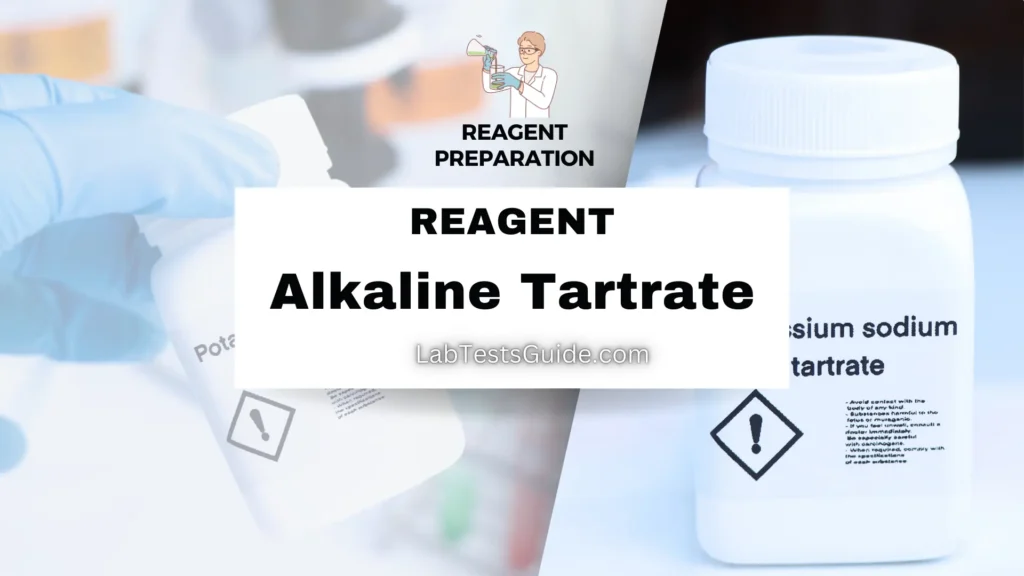Alkaline Tartrate Reagent
Alkaline tartrate reagent is commonly used in laboratory settings, particularly in biochemistry, for various assays and reactions. One of the primary applications of this reagent is in the determination of reducing sugars, where it acts as a stabilizer in some chemical reactions.

Uses of Alkaline Tartrate Reagent:
- Benedict’s Test: Identifies reducing sugars by changing color when heated with a sugar solution.
- Copper Reduction Assays: Assists in determining the presence of reducing substances in various biochemical assays.
- Colorimetric Reactions: Used in assays that involve copper ions for color development, such as in some protein assays.
- Enzyme Activity Studies: Helps in assessing enzyme activity that involves reduction reactions in laboratory experiments.
- Quality Control: Employed in analytical chemistry to verify the presence of reducing agents in various substances.
Each of these uses leverages the ability of alkaline tartrate reagent to stabilize copper ions in an alkaline environment for various chemical reactions.
Composition of Alkaline Tartrate Reagent:
| Component | Amount (for 100 ml) |
|---|
| Potassium Sodium Tartrate | 35.0 g |
| Sodium Hydroxide | 7.5 g |
| Distilled Water | To 100 ml |
Preparation of Alkaline Tartrate Reagent:
- Weigh Chemicals:
- Weigh 35.0 g of potassium sodium tartrate.
- Weigh 7.5 g of sodium hydroxide.
- Transfer both chemicals to a 100 ml volumetric flask.
- Caution: Sodium hydroxide is a corrosive, deliquescent chemical. Handle it with care and ensure the stock bottle is tightly stoppered after use.
- Dissolve Chemicals:
- Add distilled water to the flask until it is about half full.
- Stir the solution until the chemicals are fully dissolved.
- Adjust Volume:
- Continue adding distilled water to the flask until the total volume reaches exactly 100 ml.
- Mix the solution well to ensure homogeneity.
- Transfer and Label:
- Transfer the prepared reagent to a leak-proof bottle.
- Label the bottle clearly with “Corrosive”.
- Store at room temperature.
- Stability:
- The reagent is stable for at least 6 months when stored properly.
Precautions:
- Wear PPE: Use safety goggles, gloves, and a lab coat.
- Handle Sodium Hydroxide Carefully: Avoid contact with skin, eyes, and inhalation; rinse with water if contact occurs.
- Use in Well-Ventilated Area: Minimize exposure to fumes.
- Store Properly: Keep in a tightly sealed, labeled, leak-proof bottle at room temperature.
- Dispose Responsibly: Follow local regulations for hazardous waste disposal.
- Know First Aid: Have access to an eyewash station and safety shower; keep a first aid kit handy.
Uses of Alkaline Tartrate Reagent in Clinical Laboratories:
- Benedict’s Test: Detects reducing sugars in urine and other samples by causing a color change upon heating.
- Copper Reduction Assays: Measures reducing substances in various biochemical assays.
- Colorimetric Reactions: Facilitates color development in assays involving copper ions.
- Enzyme Activity Studies: Assesses enzyme activity related to reduction reactions.
- Quality Control: Verifies the presence and concentration of reducing agents in laboratory samples.
Lab Tests Guide Founder
The website covers a wide range of lab tests, including blood tests, urine tests, stool tests, and imaging tests such as X-rays and CT scans. It also provides information about different health conditions and diseases, as well as tips for maintaining good health.
It's important to note that while labtestsguide.com may provide valuable information about lab tests and their interpretation, it's always best to consult with a healthcare professional if you have any concerns or questions about your lab results. We can provide personalized guidance and advice based on your individual health status and medical history.


